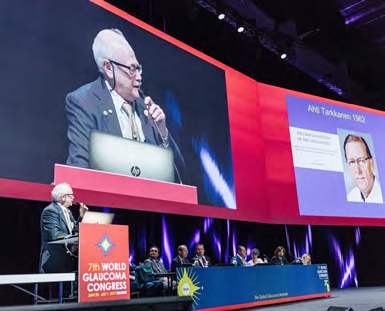advertisement

Education Committee Highlights WGC-2017
The Education Committee of the World Glaucoma Association has highlighted several WGC-2017 sessions from the Educational Portal, one of which is discussed below.From among the many high quality videos online, the committee selects for these Highlights that are of broad interest and significantly advance knowledge or provide new concepts or approaches that extend our understanding. The highlighted sessions are available free-of-charge.
Activate your WGA#One account to receive further releases of WGC-2017 content and much more – click here.
Presidential Symposium:
Exfoliation Syndrome – The first century
Chair(s):
Tin Aung (Singapore);
Robert Ritch (United States);
Anja
Tuulonen (Finland);
Hannu Uusitalo (Finland);
This Symposium addressed the 100th anniversary of the discovery of Exfoliation Syndrome (XFS) by John Lindberg.
- Introduction to the Presidential Symposium - Robert Ritch (United States)
- 100 Years of exfoliation syndrome. John Lindberg and his legacy - Ahti Tarkkanen (Finland)
- Genetics of exfoliation syndrome - Tin Aung (Singapore)
- Etiology and pathophysiology of exfoliation syndrome - Ursula Schlötzer-Schrehardt (Germany)
- Environmental determinants in exfoliation syndrome - Louis Pasquale (United States)
- Complex cataract surgery in exfoliation syndrome- avoiding trouble - Ike Ahmed (Canada)
- Rapamycin and Other Potential Drugs Targeting Exfoliation Syndrome - Najam Sharif (United States)
 Robert
Ritch, in the first
talk, gave an excellent perspective of the evolution of knowledge about exfoliation
syndrome and its current understanding as an ocular manifestation of a systemic
disease. He also presented XFS as a potential preventable or curable disorder with
many scientists from different areas doing research related to XFS.
Robert
Ritch, in the first
talk, gave an excellent perspective of the evolution of knowledge about exfoliation
syndrome and its current understanding as an ocular manifestation of a systemic
disease. He also presented XFS as a potential preventable or curable disorder with
many scientists from different areas doing research related to XFS.
Ahti Tarkkanen gave a wonderful portrait of John Lindberg and his research on XFS. He also remarked the growing interest on XFS in the medical literature, and the challenges we face with exfoliation syndrome and exfoliation glaucoma.
Tin Aung talked about the genetics of XFS, the discovery of LOXL1, and some new discov-eries, including rare variants with protective effects in some populations. He described his collaborative studies with Japanese colleagues and the Worldwide XFS Consortium that lead to the discovery of the CACNA1A gene. Dr. Aung also described his latest discoveries including 5 new loci for XFS with samples for all around the world, and talked about the possibility of using this knowledge to develop new treatments for XFS.
Louis Pasquale talked about environmental determinants of XFS. He described latitude possibly being a risk factor for the development of XFS, and climatic factors and time spent outdoors, may be important as well. Dr. Pasquale gave a fascinating explanation about UV exposure to the eyes in different parts of the world. He also mentioned other factors, including cold, low folate, coffee consumption and others.
Ursula Schlötzer-Schrehardt addressed the etiology and pathophysiology of XFS. She talked about the exfoliation material, how is formed, and aggregates. Molecular mecha-nisms are yet not fully developed. She described this syndrome as a stress-induced fibrosis, with inflammatory and other processes. The genomics era was marked by the discovery of 7 genes involved in XFS. The role of LOXL1 and other genes in forming or aggregating the exfoliation material, as well as in other mechanisms, was also discussed.
Naj Sharif talked about the current and future approaches to treatment of XFS. He discussed targeting genes or gene products in treatment. For example using TGFbeta receptor antagonists, as well as autophagy stimulators. He also talked about the need for cell lines and animal models of the disease.
Ike Ahmed talked about avoiding trouble in cataract surgery in XFS. He talked about intra and post-operative complications that may occur. How to predict zonular instability and the use of capsular tension rings and capsular retractors. The manage of late in-the-bag IOL dislocations. His presentation was illustrated with many outstanding videos.

